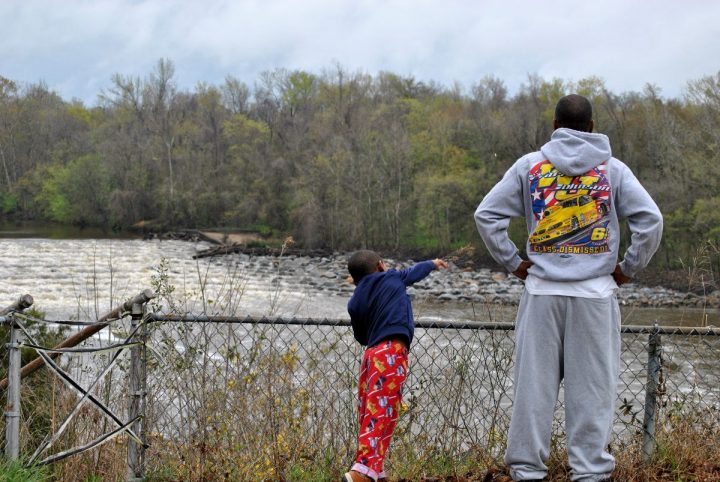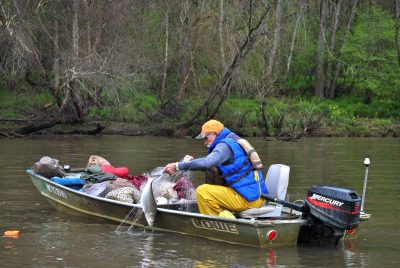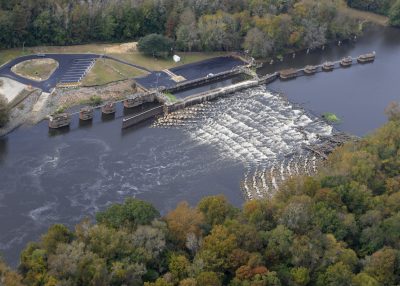
CAPE FEAR RIVER — The only thing that American shad, striped bass, and Atlantic and shortnose sturgeon want in springtime is to get up North Carolina rivers to the fall line to spawn.
Except for something to eat, of course, and in the case of the shad, they don’t even want that – they fast during the 100-mile-plus journey from the Atlantic Ocean.
Supporter Spotlight
On the Cape Fear River, their destination is thought to be the ruins of an old dam and some rapids at Smiley’s Falls, near Erwin in Harnett County. There, where the rocky Piedmont meets the Coastal Plain, is where they began life, in a spot that offers protection for offspring.
“Eggs can fall down in those cavities and be protected from predation,” said Joseph Hightower, retired North Carolina State University professor and U.S. Geological Survey biologist.
Conservation-minded folk, who want to grow the state’s fish population and with it the economy, gave the river’s anadromous, or inland-spawning, ocean-living, fish a $14 million boost in 2012. That’s when Lock and Dam No. 1 near Riegelwood was turned into a manmade rapids that the fish could swim over, rather than wait for a lift in the lock by the dam-keeper.
It was a pioneering step – the first rock arch rapids on the East Coast – but two more lock and dam combinations remain between the fish and home, No. 2 at Elizabethtown and William O. Huske No. 3 below Fayetteville.
Now a move is underway to make it possible for the fish to flip themselves unaided all the way to Harnett County.
Supporter Spotlight
The Cape Fear River Partnership, a coalition of public and private groups including Cape Fear River Watch, has cobbled together $2.3 million, with hopes of making it $3.2 million, to design and start building similar rapids or other fish passages at the remaining dams.
Moffatt & Nichol, a global infrastructure advisory firm with a Raleigh office, has already started design work.
Numbers of the fish have declined dramatically due to overfishing and the dams that 19th and 20th century industry brought to the state’s rivers. There are now catch limits on shad in the Cape Fear and a total prohibition of catching striped bass there.
There are estimated to be only 300 Atlantic and 50 shortnose sturgeon in the Cape Fear, and catching the endangered fish anywhere on the East Coast is prohibited.
“Most North Carolinians have never seen a sturgeon,” said Mike Wicker, Raleigh-based biologist for U.S. Fish and Wildlife Service. “They’ve got no idea that back in the 1800s there were these 18-foot fish and people were harvesting them for caviar.”
Shad Take The Chance
There’s evidence that the fish are responding to the boost past Lock and Dam No. 1. American shad – bony, silvery and fierce fighting – started swimming up the rapids even before they were completed.

Now, Cape Fear River Watch Executive Director Frank Yelverton says that 65 percent or more are making it over the top. When the Wildlife Commission collected eggs in 2016, 95 percent of them came from above the rapids.
Shad are historically renowned for their eggs, or roe, but even more important to North Carolina, said Wicker, is their role as food for the $2 billion saltwater recreational fishing industry.
“Speckled trout, flounder, puppy drum and even things like bluefish and tuna, king mackerel” – they all feast on shad, Wicker said. “Dolphins eat them too, porpoises … even whales.”
Reluctant Stripers
Striped bass, two or three times as big as shad and a fish that likes to swim in schools, haven’t fared as well at the rapids. Of their eggs, 97 percent were collected below the rapids, which are a carefully arranged collection of large boulders sloping up to the 11-foot-high top of the dam.
With new National Oceanic and Atmospheric Administration guidelines for rock rapids in hand, the partnership wants to make the existing rapids more attractive to the bass, which are tasty and an angler’s dream.
Under the new guidelines, boulders would be arranged so that their slope is more gradual, and instead of 18 inches between them, the space would be more like 8 feet.
Under The Radar
As for the sturgeon, the “now you see them, now you don’t” phantoms of the river, there’s evidence that some of the few remaining may also be heaving their mammoth bodies past the rapids.
The prehistoric-looking fish have changed little since dinosaur days, with long rows of bony protuberances, called scutes, down their bodies. They’ve been known to reach 800 pounds and live 60 years, though some caught in the Cape Fear estuary several years ago were closer to 80 pounds.

One researcher who caught them said that when they take one of their unexplained and prodigious leaps, “It sounds like a tree fell in the water.”
Dawn York of Wilmington environmental consulting firm Dial Cordy and Associates, which coordinates the fish-passage project for the partnership, hesitates to say that the sturgeon are definitely making it over. No tagged ones have been found past the rapids, she said.
But distinctive as they are, one veteran fisherman is sure he saw one in 2014. And last September, a researcher for an environmental consulting firm found a 4-foot juvenile tangled in his gill net at Elwell Ferry, 8 miles above the rapids.
“We let him go and he swam away in good condition,” said Mark Westendorff, senior environmental scientist for Wilmington-based consulting firm CZR Inc. “I thought it was great. “
York thought it was great, too. Though there’s a slight chance the upstream fish got a lift through the lock during infrequent maintenance, she likes to view them as evidence that the rapids work.
“The fact we’re finding them further upstream than they’re typically found means that they’re migrating and they’re looking for spawning habitat,” she said. “It demonstrates we need to continue our effort.”







